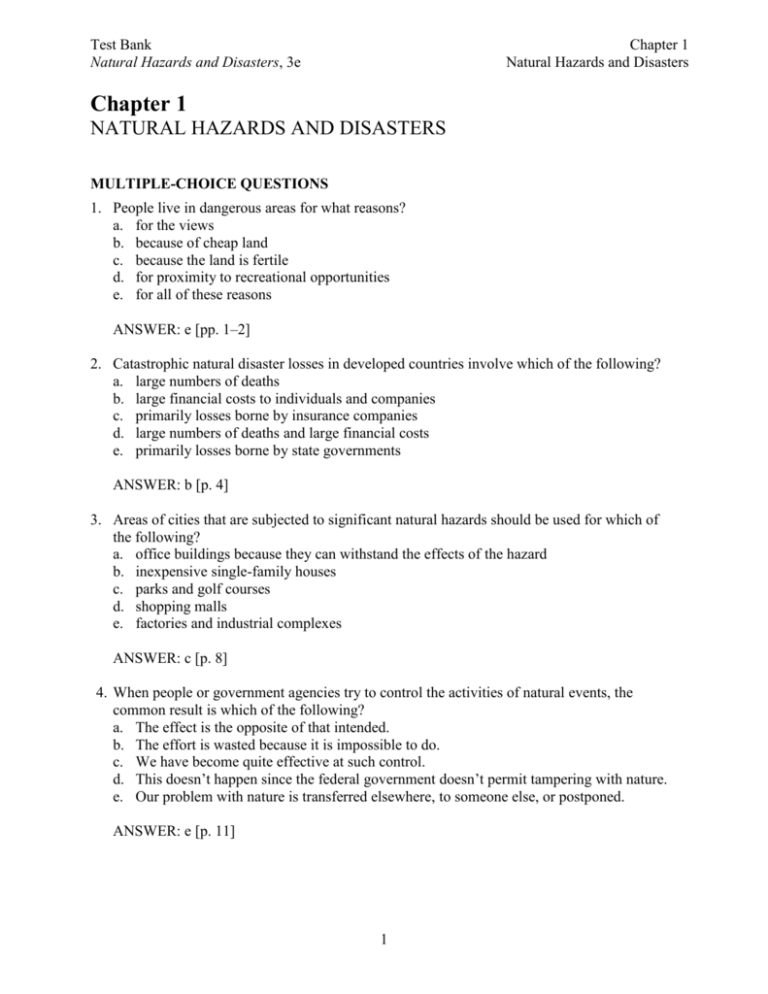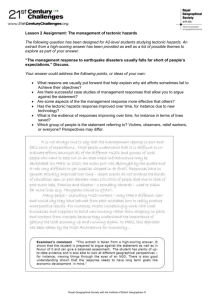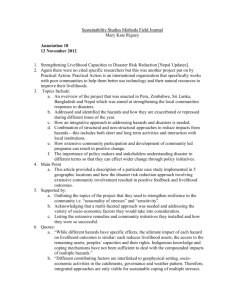2. What kind of natural hazards are not normally insurable?
advertisement

Test Bank Natural Hazards and Disasters, 3e Chapter 1 Natural Hazards and Disasters Chapter 1 NATURAL HAZARDS AND DISASTERS MULTIPLE-CHOICE QUESTIONS 1. People live in dangerous areas for what reasons? a. for the views b. because of cheap land c. because the land is fertile d. for proximity to recreational opportunities e. for all of these reasons ANSWER: e [pp. 1–2] 2. Catastrophic natural disaster losses in developed countries involve which of the following? a. large numbers of deaths b. large financial costs to individuals and companies c. primarily losses borne by insurance companies d. large numbers of deaths and large financial costs e. primarily losses borne by state governments ANSWER: b [p. 4] 3. Areas of cities that are subjected to significant natural hazards should be used for which of the following? a. office buildings because they can withstand the effects of the hazard b. inexpensive single-family houses c. parks and golf courses d. shopping malls e. factories and industrial complexes ANSWER: c [p. 8] 4. When people or government agencies try to control the activities of natural events, the common result is which of the following? a. The effect is the opposite of that intended. b. The effort is wasted because it is impossible to do. c. We have become quite effective at such control. d. This doesn’t happen since the federal government doesn’t permit tampering with nature. e. Our problem with nature is transferred elsewhere, to someone else, or postponed. ANSWER: e [p. 11] 1 Test Bank Natural Hazards and Disasters, 3e Chapter 1 Natural Hazards and Disasters 5. Natural disasters generally involve which of the following? a. events with a single clear-cut cause b. events that involve overlapping natural causes c. events wholly caused by the activities of man d. events that are unaffected by the activities of man e. events that always involve interaction between closely related processes ANSWER: b [p. 7] 6. Most natural disasters are which of the following? a. cyclic, in that they occur at predictable intervals b. rarely if ever cyclic because there are too many overlapping effects c. completely random in that they involve processes that we cannot hope to understand d. interactions between two closely related events e. processes that start small and build toward a climax at a more-or-less constant rate ANSWER: b [p. 4] 7. A fractal system is one that involves which of the following? a. numerous intersecting fractures b. similarity in form at a wide range of scales c. completely unrelated processes that interact to produce an event d. closely related processes that interact to produce a larger event e. processes that are unrelated and static ANSWER: b [p. 6] 8. An insurance company decides on the cost of a policy for a natural hazard by __________. a. adding up the total cost of the most recent disaster of the type b. multiplying the probability of the loss by the number of policies sold c. averaging their probable dollar loss for all disasters that they insure d. calculating the cost of the probable loss times the probability of that event e. multiplying the cost of the largest loss of that type times the number of times that loss has occurred ANSWER: d [p. 9] 9. The costs of catastrophic events continue to increase primarily because __________. a. more people are moving into more hazardous areas b. not enough people pay for insurance in hazardous areas to even out the costs c. insurance companies are not making enough profit to satisfy their shareholders d. insurance companies are refusing to insure most natural hazard losses e. natural hazards are becoming more difficult to understand ANSWER: a [p. 4] 2 Test Bank Natural Hazards and Disasters, 3e Chapter 1 Natural Hazards and Disasters 10. Why are most people who live on southeast-coast beaches unconcerned about hazards? a. There are few significant hazards in those areas. b. Disasters in those areas come along only about every one hundred years. c. They have never experienced a significant disaster. d. They are well insured for the types of hazards that affect those areas. e. They have built strong shoreline defenses against hazards that might affect them. ANSWER: c [p. 10] 11. What kind of natural hazards are not normally insurable? a. earthquakes b. volcanoes c. landslides d. floods e. windstorms ANSWER: c [p. 9] 12. Why don’t many coastal communities try to educate visitors and new residents about natural hazards in their areas? They view such information as __________. a. bad for business b. too difficult for most people to understand c. a national security issue d. information an insurance company might use to their advantage e. classified information to be used only by the Federal Emergency Management Agency ANSWER: a [p. 10] 13. What is the normal relationship between the number of a particular type of event and the size of such events? a. There is an equal number of small, medium, and large events of any given type. b. There are few small events, a moderate number of larger events, and many giant events of any given type. c. There are many small events, many medium-size events, but for most hazards no giant events. d. There are many small events, a moderate number of larger events, and few giant events of any given type. e. For most types of natural hazards, there are medium and large events but no small events of equivalent type. ANSWER: d [p. 6] 3 Test Bank Natural Hazards and Disasters, 3e Chapter 1 Natural Hazards and Disasters 14. When is a large event such as a major earthquake not a disaster? a. when it happens in a far away country that we do not care about b. when it happens to less than 10,000 people c. when it happens to less than 1,000 people d. when it happens in an area without any people e. when it happens in a third-world country in which more than 20 percent of the population subsists on less than $2 per day ANSWER: d [p. 3] 15. Who is most commonly to blame when people incur a significant loss from a natural disaster? a. the U.S. Army Corps of Engineers for not building protective structures b. the federal government for not doing something about it c. the people themselves for choosing to live there d. the local county for permitting them to build there e. the realtor for selling them the property ANSWER: c [p. 1] 16. What can happen to make a moderate-size event into a large natural disaster? a. cyclic events that tend to get stronger with time b. overlapping events that amplify the effect c. cyclic events that get progressively bigger as each one adds to the next in the series d. the multiplying effect of events of a given type in the same area e. overlapping events that interfere with one another ANSWER: b [p. 7] 17. If you erect a barrier for protection against some natural event, what detrimental effect can follow? a. You shouldn’t try to do so because such barriers typically cost more than the structures they are designed to protect. b. National laws require that anything that interfaces with natural processes be done by federal agencies. c. Similar projects by others nearby will make your efforts ineffective. d. Nature is strong enough to immediately overwhelm your efforts, which are then wasted. e. It can have detrimental effects on others nearby. ANSWER: e [p. 11] 4 Test Bank Natural Hazards and Disasters, 3e Chapter 1 Natural Hazards and Disasters 18. Which of the following is an example of the domino effect? a. a landslide caused by a sudden precipitation event b. an increase in the cost of gasoline that causes people to drive less c. global warming that causes more rapid melting of Arctic sea ice that results in further sea ice melting d. when a feature looks the same across a wide range of scales e. an earthquake that occurs in a developing nation that causes health, social, and economic problems ANSWER: c [p. 7] 19. Which of these natural hazards causes the LEAST amount of fatalities in the United States annually? a. volcanoes b. heat and drought c. lightning d. winter weather e. tornadoes ANSWER: a [p. 4] 20. Which is NOT a way that government policy mitigates natural hazards? a. using research and studies to predict storms and floods b. congress funding expensive Army Corps of Engineers projects to build levees along rivers c. relocating natural disaster victims to more stable areas d. utilizing computer systems to determine risk levels e. organizing central emergency management agencies to bring order to chaotic relief efforts ANSWER: b [p. 10] SHORT ANSWER QUESTIONS 1. Why are people who live on coastal beaches so poorly aware or concerned about hazards in those environments? ANSWER: Most of them, including developers, real estate people, and governmental employees, have never experienced a hurricane or major flood. [pp. 1, 10] 2. What kind of natural hazards are not normally insurable? ANSWER: Landslides, most mudflows, ground settling, or swelling soils. [p. 9] 3. Why do many coastal communities not educate visitors and new residents about natural hazards in their areas? ANSWER: They view such information as bad for tourism and bad for business. [pp. 10–11] 5 Test Bank Natural Hazards and Disasters, 3e Chapter 1 Natural Hazards and Disasters 4. What is the normal relationship between the number of occurrences of a particular type of event and the size of such events? ANSWER: Numerous small events, many fewer large events, and only a rare giant event. [p. 6] 5. When is a large event such as a major earthquake not a disaster? ANSWER: When it happens in a remote area and does not affect anyone. [p. 3] 6. When people incur a significant loss from a natural disaster, who is most commonly to blame and why? ANSWER: People themselves are to blame because they place themselves in the environment of such large natural events. [pp. 1–3, 11] 7. What can happen to make a moderate-size event into a large natural disaster? ANSWER: Overlapping events that amplify the effect. [p. 7] 8. If you erect a barrier for protection against some natural event, what detrimental effect can follow? ANSWER: It can affect people in other locations (such as downstream). [p. 11] 9. How does government policy sometimes act counterproductively in reference to mitigating natural hazards? ANSWER: Congress funds losses but does not act to change the causes of natural disasters: The Small Business Association subsidizes credit to finance rebuilding in hazardous locations, and so on. Government is reactive to disasters instead of proactive. [pp. 9–10] 10. A natural disaster is fractal. Explain what this means and how it provides insight into larger events. ANSWER: A natural disaster looks the same across a wide range of scales. Small events today may provide insight into huge ones from historical time. [p. 6] CRITICAL THINKING ESSAY QUESTIONS 1. You are on the zoning board for a small town near an active fault line. The board is deciding how to efficiently accommodate a larger student body by either choosing to (1) renovate the town’s existing high school or (2) build a new school for the same cost on cheap land closer to the fault line. Explain why it would be better to renovate the school at the current location than to build a new school for the same price. ANSWER: Building on cheap land close to a natural hazard is more dangerous; the town would be better off renovating the existing structure. [pp. 1–2] 2. Your mother, who has lived in central Ohio for her entire life, really wants to purchase a beach house along the Gulf coast of the southeastern United States because of the natural beauty of the area. Explain to her why this is not a financially or safety-related decision. 6 Test Bank Natural Hazards and Disasters, 3e Chapter 1 Natural Hazards and Disasters ANSWER: Your mother is probably not aware of the dangers of coastal storms, and local realtors and government from coastal areas might not publicize the dangers of the natural hazards in coastal regions. [pp. 1–2, 10] 3. Would you rather live in an area that has historically experienced a natural hazard, a natural disaster, or a catastrophe? Is there any environment in which these processes do not exist? ANSWER: A natural hazard would be the least threatening of the three processes, but given changing population densities and infrastructure, a situation that was once considered a hazard could later be considered a catastrophe. Very few places are free of all natural hazards, but efforts can be made to minimize the people living in the most hazardous areas. [pp. 3, 11] 4. After a hurricane devastates a coastal community, you are a part of a team of people going in to help victims cope with the disaster and rebuild their lives. One victim is very set on rebuilding his home in the exact same location as before the disaster. What would you say to that victim and what advice would you give him? ANSWER: Natural disasters can be cyclic and repeat over time. Even though it is inexpensive to rebuild in the same location, it would be a reaction to the disaster and not a proactive solution to future disaster events. [pp. 4–6, 10–11] 5. When you are buying a home, what types of landscapes can you look for to determine if the home you are looking into purchasing is potentially susceptible to natural disasters? ANSWER: Ash or mud deposits from volcanoes, lumpy landscapes from landslides, sinkholes from underlying geologic processes, meanders from meandering streams, or undercut sea cliffs from storm waves. [p. 10] 7






